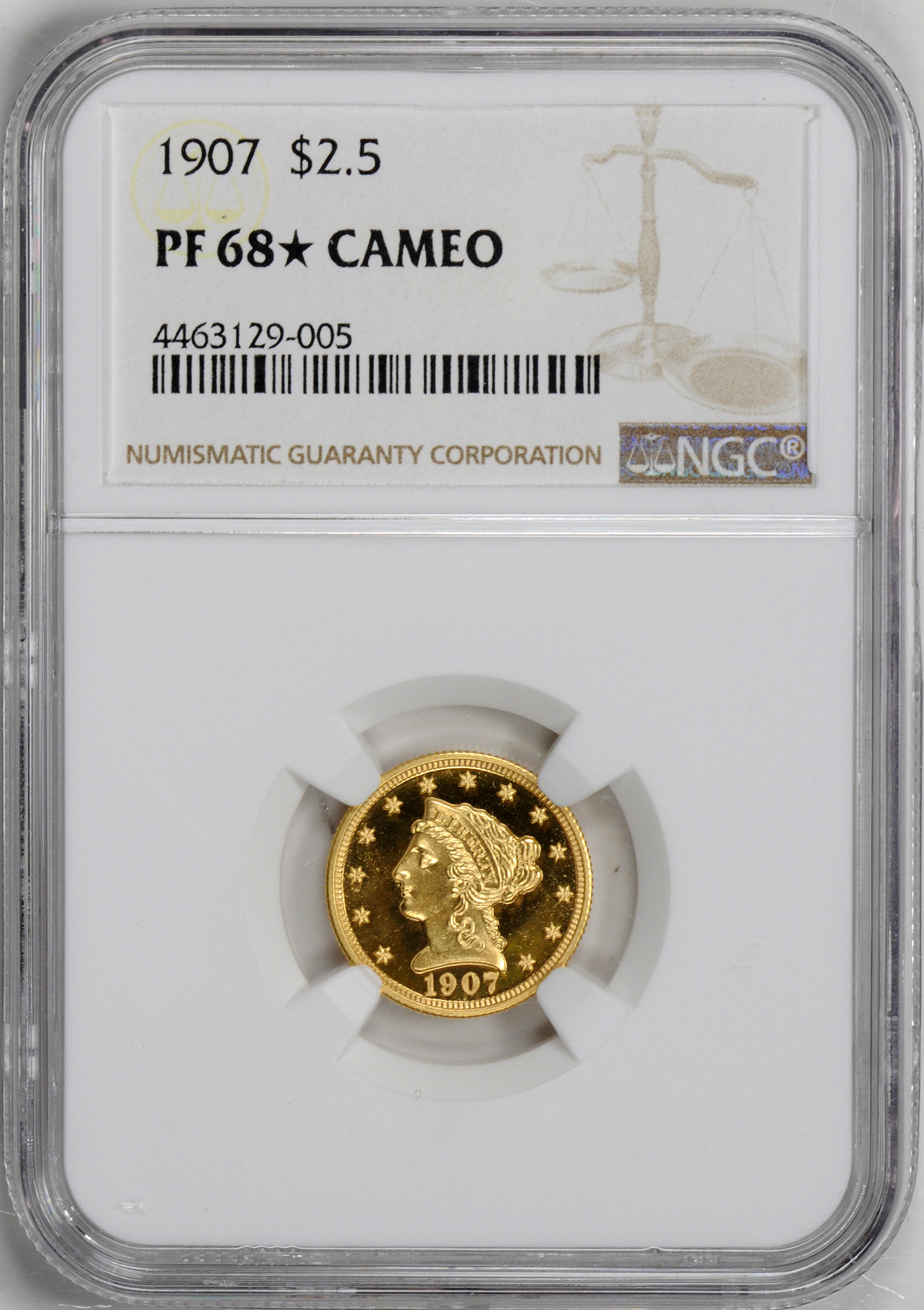CALL NOW for the Monthly Morgan Specials!
Numismatic Silver
DESIGNER
George T. Morgan
FACE VALUE
$1.00
MINTED
1878 - 1921
PRECIOUS METAL CONTENT
90% Silver
DIAMETER
38.1mm

MORGAN SILVER DOLLAR
The Morgan Dollar was minted from 1878 to 1904 with one reissue in 1921, and it was struck at five U.S. Mints: Carson City, Philadelphia, San Francisco, New Orleans, and Denver. The coin came to life after the largest silver strike in the world: the 1859 Comstock Lode, which was a large silver deposit in Nevada, named after Henry Comstock, who was a part-owner of the property where it was discovered in June 1859. The lode resulted in a huge flood of silver to the market. However, in 1873, The Coinage Act put an end to the manufacture of silver coins in the United States as values dropped. The Bland-Allison Act made silver legal tender alive again in 1878, requiring the U.S. Treasury to purchase a certain amount of silver and minting 2 million silver dollars per month. This is when the Morgan Silver dollar started being produced until the year 1904.
In the early 1900s, the Comstock lode was deteriorating as the supply of silver was decreasing, which resulted in a halt in silver coinage production. Then came the Pittman Act in 1918, which resulted in the melting down of over 270 million stored Morgan Silver Dollars and the selling of the bullion abroad, leading to a reissue of the Morgan Silver Dollar in 1921.
DESIGNER
Anthony de Francisci
FACE VALUE
$1.00
MINTED
1921 - 1935
PRECIOUS METAL CONTENT
90% Silver
DIAMETER
38.1mm
SILVER PEACE DOLLAR
It is the very end of 1921. World War I is still fresh in the minds of the world, and there are still several years before the coming Great Depression. America is in the middle of an economic boom and needs silver coins to replace all of the Morgan dollars melted down by the Pittman Act. The Peace Dollar, Designed by Anthony de Francisci, was named to commemorate the end of the war to end all wars. The Peace Dollar was the last 90% silver dollar put into circulation in America until the issuance of the Eisenhower Dollar, and later the Susan B. Anthony dollar. The Peace Dollar carried America through the roaring twenties and the Great Depression, but its production ceased soon after that.
Peace Dollars, from their high relief origins in 1921 to their Great Depression discontinuation in 1935, are an American classic and are perfect for anyone looking for Americana, history, and of course, a timeless design struck in .900 fine silver.
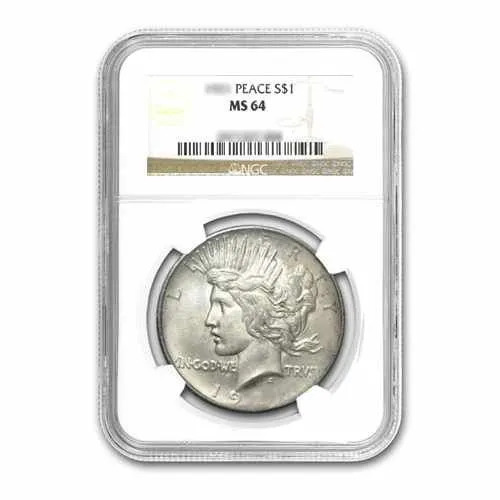
Numismatic Gold
DESIGNER
Augustus Saint-Gaudens
FACE VALUE
$20.00
MINTED
1907-1933
PRECIOUS METAL CONTENT
.9675 oz. Pure Gold
DIAMETER
34mm

Saint-Gaudens Double Eagle
In 1905, while touring the Smithsonian Institute, President Theodore Roosevelt marveled at the ancient Greek coinage on display and asked himself why American coinage seemed so "bland." Compared to Greek coinage, Roosevelt felt that our nation's coins were "artistically of atrocious hideousness." The beauty of the classic Greek coins crystallized his decision to launch new designs for the whole range of U.S. Coins.
Roosevelt felt that coins were more than round bits of metal--he felt that they reflected a country's greatness. By 1905, America had grown to become the most powerful nation on earth. Roosevelt wanted to see coin designs that would reflect America's pre-eminent status. The president contacted the artist who had created his 1905 inauguration medallion, Augustus Saint-Gaudens. He asked the aging sculptor to produce a new series of coins. For a fee of $5,000. Saint-Gaudens agreed to produce a variety of coins similar to the ancient Greek coins, which Roosevelt admired.
Unfortunately, Saint-Gaudens died of cancer before his task was completed, but his majestic Double Eagle $20 gold piece is considered to be the most beautiful coin of all time and, to this day, it is the most famous of all of Saint-Gaudens' works of art. On the obverse of the coin, Liberty is portrayed striding toward the viewer into the dawn of a new day. In her right hand is a torch held aloft, and in her left hand is an olive branch. The Capitol building can be seen in the background to the lower left. At the top is the word LIBERTY and around the border are 46 stars representing the states of the Union in 1907. The setting for the obverse was taken from Saint-Gaudens' much acclaimed Victory, a sculpture that is part of the Sherman Monument in New York City's Central Park. The reverse of the coin depicts an American eagle in flight above the sun's rays, with the inscription “UNITED STATES OF AMERICA TWENTY DOLLARS” arching across the top.
When Theodore Roosevelt first viewed Saint-Gaudens' Double Eagle design, he knew that the artist had created a coin that would be admired for ages. What he did not know, however, was that a quarter-century later, his cousin, Franklin Delano Roosevelt, would confiscate all privately-owned gold and most of these beautiful works of art would be melted into lifeless bars.
DESIGNER
Augustus Saint-Gaudens
FACE VALUE
$10.00
MINTED
1907-1933
PRECIOUS METAL CONTENT
.48375 oz. Pure Gold
DIAMETER
27mm
Indian Eagle
The golden era of American coinage grew out of a president's trip to a museum. In 1905, Theodore Roosevelt attended an exhibition of ancient Greek coins at the Smithsonian and was greatly impressed by their. artistic beauty and symbolic power. In comparison, he felt American coins were altogether bland and unworthy of our nation. He envisioned an entire new generation of coins that would represent the greatness of an America awakening to its emerging power and importance in the world, and he knew just the man who could pull it off, the great sculptor of his inauguration medal, Augustus Saint-Gaudens,
In 1905, Saint-Gaudens was not only the most prominent sculptor in the country, he was one of the most important American artists of any kind. Directly embodying the spirit of the American Renaissance. Upon hearing of Roosevelt's desire for a reworking of the nation's coinage, Saint-Gaudens readily agreed to take up the challenge and began work on the Double Eagle $20 and Eagle $10 gold pieces immediately, Saint-Gaudens passed away before he could complete designs for the entire run of American coins, but he did leave us with two masterpieces. The Eagle's obverse is taken directly from his monument to General William T. Sherman in New York's Central Park. It depicts Lady Liberty in profile facing left and wearing the Native American feathered war bonnet that President Roosevelt insisted upon. The reverse of the coin captures a bold American eagle perched proudly upon a bundle of arrows, beneath the inscriptions “United States of America". Initially, President Roosevelt mandated that the motto "In God We Trust" be omitted from the coin's design, reasoning that they could conceivably be used for gambling or illicit purposes. However, in 1908, the motto was reinstated by an act of Congress and remained through the end of the series in 1933.
The Indian Eagle was not without scandal, however. The obverse design, featuring Miss Liberty adorned by a full Indian war bonnet with star-tipped feathers caused quite a stir. The public got over their initial shock and quickly grew to appreciate the bold new design. Saint-Gaudens Indian Head Eagles, which replaced the $10 Liberty, were minted from 1907 through 1933 in Philadelphia (no mintmark), San Francisco (“S”), and Denver (“D”), are composed of .90% gold yielding .48375 troy ounces of pure gold per coin, and measure 27mm in diameter. The edges of eagles minted from 1906 to 1911 are decorated with 46 raised stars, one for each state in the Union. Two more stars were added after 1912, recognizing two new states that entered the Union in that year.
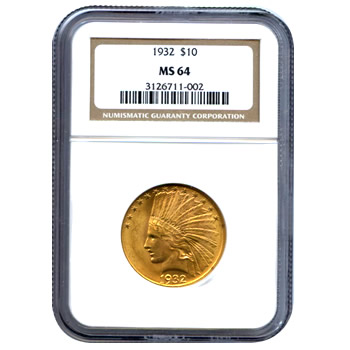
DESIGNER
Bela Lyon Pratt
FACE VALUE
$5.00
MINTED
1908-1929
PRECIOUS METAL CONTENT
.24187 oz. Pure Gold
DIAMETER
21.6mm
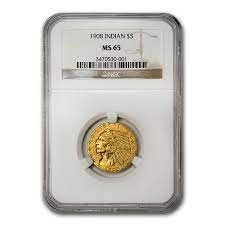
Indian Half Eagle
Few coins have as much beauty, intricacy of design, and appeal as the Indian Half Eagle. A
proud Native American Chieftain, the model unnamed and his tribe unknown, dominates the obverse of the Half Eagle. On the reverse, an American eagle rests atop a bundle of arrows and an olive branch, symbols of military preparedness and peace, respectively. When the coin was first circulated, it caused a great deal of controversy. The main concern was that the recessed design housed disease-carrying bacteria. Thus, the public was understandably reluctant to preserve even uncirculated specimens for generations to follow. Furthermore, because Pratt did not choose to use rims to protect the surface of the coin, uncirculated examples are scarce and superb gems are virtually unheard of.
The quality that sets these coins apart from all others stylistically is their unprecedented incuse relief: unlike any other modern design, the images and inscriptions on the Indian Head Half Eagle are sunken into the surface of the coin. The revolutionary idea for minting an American coin with incuse relief bears the mark of two men: the young and dynamic President Roosevelt, eager to leave a mark on the country, and his good friend, physician and art lover William Sturgis Bigelow. Bigelow approached the president with the idea for a coin with recessed features after seeing an exhibition of ancient Egyptian coins with a similar design at the Boston Museum of Fine Arts, and Roosevelt was soon taken with the desire to apply the idea to an American coin. With the president's blessing, Bigelow moved forward with the project, challenging Boston artist Beta-Lyon Pratt with the commission_
Indian Head Half Eagles were minted from 1908 through 1929 in Philadelphia (no mintmark), San Francisco ("S'' mintmark), New Orleans (“O”), and Denver (“D"), are composed of .90% gold yielding .24187 troy ounces of pure gold per coin, and measure 21.6mm in diameter.
DESIGNER
Bela Lyon Pratt
FACE VALUE
$2.50
MINTED
1908-1929
PRECIOUS METAL CONTENT
.12094 oz. Pure Gold
DIAMETER
18mm
Indian Quarter Eagle
President Theodore Roosevelt commissioned sculptor Augustus Saint-Gaudens to redesign all American coinage, but Saint-Gaudens died of cancer after completing design work for the $10 (Eagle) and $20 (Double Eagle) gold pieces. Fortunately, in late 1907 Roosevelt was able to contact one of Saint-Gaudens' students, Bela Lyon Pratt, and commission him to redesign the $2.50 and $5.00 denominations. A year later, the numismatic community was surprised by Pratt's innovative Indian head gold coin design, which featured the legends and motifs incused rather than raised on the coin. In other words, unlike any other modern design, the images and inscriptions on the Indian Head Quarter Eagle are sunken into the surface of the coin. These are the only U.S, coins minted in this manner.
The revolutionary idea for minting an American coin with incuse relief bears the mark of two men: the young and dynamic President Roosevelt, eager to leave a mark on the country, and his good friend, physician and art lover William Sturgis Bigelow. Bigelow approached the president with the idea for a coin with recessed features after seeing an exhibition of ancient Egyptian coins with a similar design at the Boston Museum of Fine Arts, and Roosevelt was soon taken with the desire to apply the idea to an American coin. With the president's blessing, Bigelow moved forward with the project, challenging Boston artist Bela-Lyon Pratt with the commission. Pratt sculpted an obverse depicting a Native American in full headdress surrounded by thirteen stars. On the reverse side, an American eagle stands atop fasces and an olive branch, symbols of military preparedness and peace.
One reason the $2.50 Indian is such an attractive gold investment and collector's item is that this Quarter Eagle gold coin was minted during only 13 years, making it one of the shortest-lived series in U.S. Numismatics. Quarter Eagles of this type were produced in 1908 through 1915 and again from 1925 through 1929, after which time the denomination was suspended.
Indian Head Quarter Eagles were minted in Philadelphia (no mintmark), and Denver (“D"), are composed of .90% gold yielding .12094 troy ounces of pure gold per coin, and measure 18mm in diameter.

DESIGNER
James B Longacre
FACE VALUE
$20.00
MINTED
1849 - 1907
PRECIOUS METAL CONTENT
.9675 oz. Pure Gold
DIAMETER
34mm

Liberty Double Eagle
From out of the boom of the California gold rush of the late 1840's came America's largest circulating gold coin, the Double Eagle or $20 gold piece. Until 1849, the U.S. Mint produced only $2.50, $5 and $10 coins. The discovery of gold at Sutter's Mill and the ensuing California gold rush, however, soon prompted the Treasury to expand its plans for a $1 gold piece to include the much larger Double Eagle. On March 3, 1849, Congress passed the authorizing legislation and the Double Eagle was born.
The Liberty Head Double Eagle was designed by embattled Chief Engraver James Barton Longacre, best known for his work on the Indian Head Penny. The coin's obverse draws inspiration from the ancient Greco-Roman sculpture Crouching Venus: it depicts Liberty in sharp profile, facing left, and wearing a pearl-studded diadem inscribed "Liberty'. The reverse is modeled on the Great Seal of the United States, depicting a heraldic eagle with a shield on its breast beneath a ring of thirteen stars, These coins have a certain majesty befitting their status and face value.
In January 1650, the first regular production Liberty Double Eagle gold coins were struck. Over the years, this $20 Liberty gold coin produced was in three types,
Type I, the "No Motto" variety, minted from 1849 to 1866.
Type ll, bearing the designation "Twenty D" on the reverse, minted from 1866 to
1876, followed by the most common variety.
Type III (1877-1907), with "Twenty Dollars" fully spelled out.
The Double Eagle gold coin, which offers the highest gold content of any regular issue U.S. gold coin of its era, is a keepsake that remains a tangible reminder of our rich, hard-money heritage.
Liberty Head Double Eagles were minted in three slight variations from 1849 through 1907 in Philadelphia (no mintmark), San Francisco (''S'' mintmark), New Orleans ("0"), Carson City, Nevada (“CC”), and Denver (“D"), are composed of .90% gold yielding .9675 troy ounces of pure gold per coin, and measure 34mm in diameter.
DESIGNER
Christian Gobrecht
FACE VALUE
$10.00
MINTED
1838 - 1907
PRECIOUS METAL CONTENT
.48375 oz. Pure Gold
DIAMETER
27mm
Liberty Eagle
In 1838, after an absence of thirty-four years, a new Eagle $10 gold piece was finally introduced. So many of the previous generation of Gold Eagles had been hoarded or melted down as a result of the discrepancy between their face value and compositional worth that President Jefferson was moved to completely end their production in 1804. The Congress, though, was determined to maintain a bi-metallic standard, and, after much debate on fineness and composition, did so in 1838 by passing the two bills that authorized the production of a new Gold Eagle,
Acting Engraver Christian Gobrecht was charged with designing the coin that would come to be known as the Liberty Head Eagle. The coin's obverse, patterned after the popular 1816 Coronet-type Large Cent, was inspired by Benjamin West's famous painting Omnia Vincit Amor (“Love Conquers All”). It depicts a left-facing bust of Liberty, hair knotted in back with hanging curls, wearing a coronet inscribed "Liberty". The reverse features a very naturalistic American eagle, considered one of the most fascinating eagles ever to grace any U.S. Coin, holding arrows and an olive branch in its talons with a shield across its breast.
Because of its convenient size and denomination, the $10 Liberty was instantly popular and became one of the most circulated coins in U.S. history. They were hoarded during the Civil War, when it took $25 in paper "greenbacks" to buy just one $10 Liberty.
Liberty Head Double Eagles were minted in two slight variations from 1838 through 1907 in Philadelphia (no mintmark), San Francisco (“S" mintmark), New Orleans (“O”), Carson Carson City, Nevada ("CC"), and Denver (“D"), are composed of .90% gold yielding .48375 troy ounces of pure gold per coin, and measure 27mm in diameter.
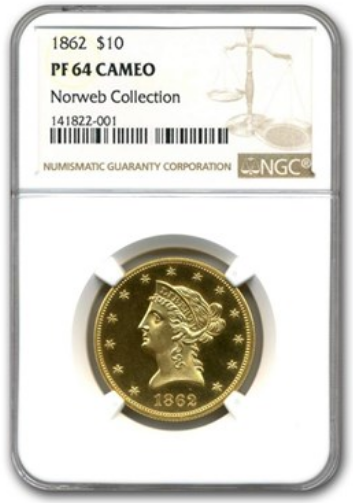
DESIGNER
Liberty Half Eagle
FACE VALUE
$5.00
MINTED
1839 - 1908
PRECIOUS METAL CONTENT
.24187 oz. Pure Gold
DIAMETER
21.6mm

Liberty Half Eagle
The Liberty Half Eagle holds the distinction of being the only coin of any type or denomination to be struck at all seven mints. They were struck in two types--the ultra-scarce "No Motto", minted from 1839 until 1865 and the ''With Motto" (IN GOD WE TRUST) type, struck from 1866 until '1908'.
During the Civil War, widespread gold hoarding led the U.S. government to significantly reduce the mintages of these coins, making issues from that era particularly rare,
The Liberty Head Half Eagle.$5 gold pieces shared a design with the new Eagles released the year before and the Quarter Eagles that would arrive the following year, thus continuing the Mint's long tradition of uniformity among the nation's coins. Acting Engraver Christian Gobrecht whose artistic style was heavily influenced by the Neoclassicism of the day, was charged with designing the new gold pieces.
The Half Eagles' obverse, inspired by Benjamin West's famous painting Omnia Vincit Amor ("Love Conquers All"), depicts a left-facing bust of Liberty, hair knotted in back with hanging curls, wearing a coronet inscribed 'Liberty", The reverse features a very naturalistic American eagle holding arrows and an olive branch in its talons with a shield across its breast. By looking backward to antiquity, Gobrecht's design offered the American people an aura of stability and assurance in a time of great social and technological change.
Liberty Head Half Eagles were minted in two slight variations from 1839, through 1908 in Philadelphia (no mintmark), San Francisco (“S” mintmark), Charlotte, North Carolina ("C"). Dahlonega, Georgia (“D"), Carson City, Nevada (“CC”), New Orleans ("O”), and Denver (“D''), are composed of .90% gold yielding .24187 troy ounces of pure gold per coin, and measure 21.6mm in diameter.
DESIGNER
Liberty Half Eagle
FACE VALUE
$2.50
MINTED
1839 - 1908
PRECIOUS METAL CONTENT
.12094 oz. Pure Gold
DIAMETER
18mm
Liberty Quarter Eagle
Modeled after the Coronet-type Large Cent (1816-1857), Christian Gobrecht's Quarter Eagle $2.50 Gold Liberty design continued unchanged for 33 years, longer than any other design in the history of American gold coinage. The obverse contains a bust of the crowned image of Miss Liberty facing to the viewer's left. The reverse is decorated by an American bald eagle clutching an olive branch and arrows in its talons.
The Liberty. Head Quarter Eagle $2.5 gold pieces introduced in 1840 shared a design with the new Eagles of 1838 and the Half Eagles of 1839, thus continuing the Mint's long tradition at uniformity among the nation's coins. Acting Engraver Christian Gobrecht, whose artistic style was heavily influenced by the Neoclassicism of the day, was charged with designing the new gold pieces. The Half Eagles' obverse, inspired by Benjamin West's famous painting Omnia Vincit Amor ("Love Conquers All" ), depicts a left-facing bust of Liberty, hair knotted in hack with hanging curls, wearing a coronet inscribed "Liberty'. The reverse features a very naturalistic American eagle holding arrows and an olive branch in its talons with a shield across its breast. By looking backward to antiquity, Gobrecht's design offered the American people an aura of stability and assurance in a time of great social and technological change.
Liberty Head Quarter Eagles were minted in two slight variations from 1840 through 1907 in Philadelphia (no mintmark), San Francisco (“S” mintmark), Charlotte, North Carolina ("C”), Dahlonega, Georgia (“D”), and New Orleans ("0"), are composed of .90% gold yielding 0.12094 troy ounces of pure gold per coin, and measure 18mm in diameter.
